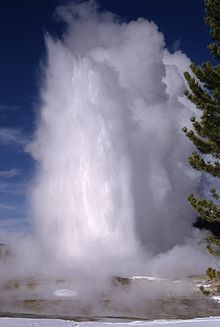Giant geyser
Coordinates: 44 ° 28 '15 " N , 110 ° 50' 27" W.
The Giant Geyser (English Giant Geyser ) is a cone-shaped geyser in the Upper Geyser Basin in Yellowstone National Park in the US state of Wyoming . The Giant Geyser is also the namesake for the Giant Geyser Group , to which the Giant Geyser as well as Bijou Geyser and the Mastiff Geyser belong. The geyser also gives its name to the Giant Platform , an elevated stone plateau on which the three geysers are located. The Giant Geyser is best known for the spectacular fountains, which are up to two meters in diameter, and the four-meter high cone.
history
On September 18, 1870, the eruption of the Giant was first observed by the Washburn-Langford-Doane Expedition team . After exploring and exploring the Upper Geyser Basin for a day and a half, they named seven geysers in the basin, including the Giant. Nathaniel P. Langford described the Giant as follows in 1871 :
“The Giant” has a robust crater with an outer diameter of approx. 3.3 m and an irregularly structured inner diameter of approx. 2 m. We only saw the eruption once and it was huge. With a diameter of almost 2 m, the fountain shot up to 46 m in height for 3 hours. The crater also resembles a miniature of the Colosseum.
Eruptions
The eruption takes place very irregularly. Sometimes it takes a few days, sometimes a few weeks. In addition, the activity varies considerably from year to year. Occasionally there are huge eruptions that last several hours and are up to 80 m high. From 1955 it erupted extremely frequently for several years, in contrast to only six eruptions between 1963 and 1987. From 1997 the Giant was more active again and eruptions took place about every four days. The last active phase for the time being began on August 6, 2005 and lasted until April 29, 2008, when the activity then decreased significantly, but did not come to a standstill, because on August 26, 2008 another eruption took place. A total of eleven eruptions took place in 2005, 47 in 2006, 54 in 2007 (which was also the highest number of eruptions in the Giant since 1955) and 15 in 2008. The reasons for the extreme fluctuations in activity are unknown, but it is believed that they are based on geothermal energy fluctuations between the Giant and the nearby Grotto Geyser .
The height of the fountains and the relatively frequent eruptions in recent years have prompted researchers to examine the Giant many times, making it one of the best-studied geysers in the park. On the basis of these studies, much could be deduced or learned about the eruption behavior of geysers. Steam development and bubbling of the geyser can always be observed in the inactive phases of the geyser, but eruptions only occur very rarely during the inactive times of the geyser.
Web links
- Giant Geyser eruption on June 28, 2007 (youtube video) . Retrieved December 31, 2010.



